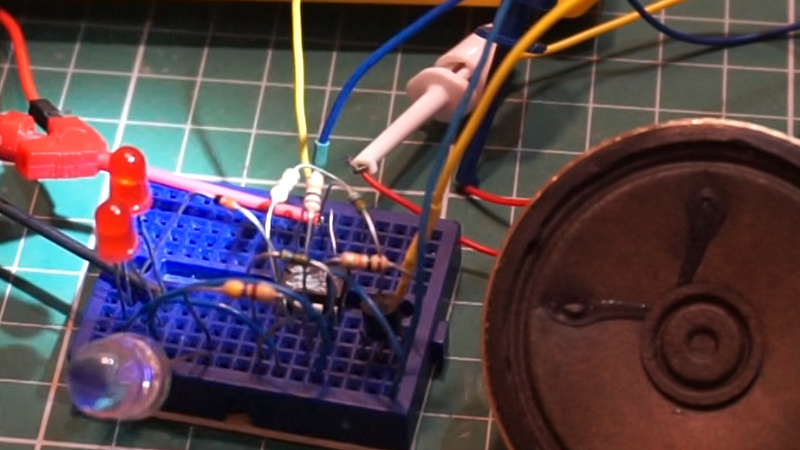The function of an LED is to emit light when the device is forward biased within its operating range, and it’s known by most people that an LED can also operate as a photodiode. Perhaps some readers are also aware that a reverse biased LED also has a significant capacitance, to the extent that they can be used in some RF circuits in the place of a varicap diode. But how do those two unintentional properties of an LED collide? As it turns out, an LED can also behave as a light dependent capacitor. [Bornach] has done just that, and created a light dependent sawtooth oscillator.
The idea is simple enough, there is a capacitance between the two sides of the depletion zone in a reverse biased diode, and since an LED is designed such that its junction is exposed to the external light, any photons which hit it will change the charge on the junction. Since the size of the depletion zone and thus the capacitance is dependent on the voltage and thus the charge, incoming light can thus change the capacitance.
The circuit is a straightforward enough sawtooth oscillator using an op-amp with a diode in its feedback loop, but where we might expect to find a capacitor to ground on the input, we find our reverse biased LED. The video below the break shows it in operation, and it certainly works. There’s an interesting point here in that and LED in this mode is suggested as an alternative to a cadmium sulphide LDR, and it’s certainly quicker responding. We feel duty bound to remind readers that using the LED as a photodiode instead is likely to be a bit simpler.
This project is part of the Hackaday Component Abuse Challenge, in which competitors take humble parts and push them into applications they were never intended for. You still have time to submit your own work, so give it a go!

















Tape a forward biased LED to it and get a voltage controlled capacitor?
Current controlled.
It’s like an optocoupler, but freakier
Tape a forward biased LED with programmable current driver to it and get a digitally controlled capacitor?
Think of the diode PN junction as a sponge. When you apply a reverse voltage, the sponge gets “emptier”, impacting how much water it can hold. The quicker you push (change the voltage), the more it “reacts,” acting like a capacitor. Similar trick is used in old russian radars to generate microwave radiation.
Yes, this is a way of making a voltage controlled oscillator (VCO). The LED acts as a “varicap”. You typically isolate the DC varicap bias away from the oscillator by putting a normal capacitor between them.
Next step: use two LEDs aimed at each other, and figure out what voltage is needed on the emitting LED to make different musical pitches. Then make an amplifier circuit to turn 1 V / octave into the right curve, and you’ve got yourself a wacky new Eurorack module.
Before one of the typical Hackaday commenter pedants comes out: current, whatever, you know I assumed there’s a series resistor.
Well hello! I am one of them “pedants” with a pedantic comment. LED brightness isn’t a function of voltage, but current. How will placing a series resistance change provide meaningful control? LEDs are nonlinear.
The current through an LED is a function of voltage – and non-linear as you point out. This works to our advantage in this case. To get from linear voltage to logarithmic for the musical octaves, the typical logarithmic amplifier actually uses the V-I curve of a diode near the threshold to do the conversion.
There’s an old trick about using a reverse biased LED as a light meter by repeatedly charging and discharging it, and counting how long it takes.
There’s two effects going on: the varying capacitance AND the fact that the diode is acting as a tiny solar cell to charge it.
I’ve used cheap rectifier diodes as varicaps before. For my project, adding some tuning control to a fixed BFO it worked great! When I learned that trick I heard LEDs work even better but you have to paint them or something to keep it from being light sensitive. So.. no surprises this works, awesome!
Hams have been using reverse biased LEDs as voltage variable capacitors without the light pretty much from day one.
I don’t see where the article’s claim “As it turns out, an LED can also behave as a light dependent capacitor.” comes from. The linked page says that the photo-current varies with light intensity (if it’s the right wavelength), and charges the capacitor at a rate that varies with that light intensity. Is there a source for the claim that the capacitance actually changes?
So the capacitance does change with the bias voltage according to https://left.engr.usu.edu/courses/5420/PN%20Junctions.html
However it still seems like the important thing is the varying photo-current, not varying capacitance.